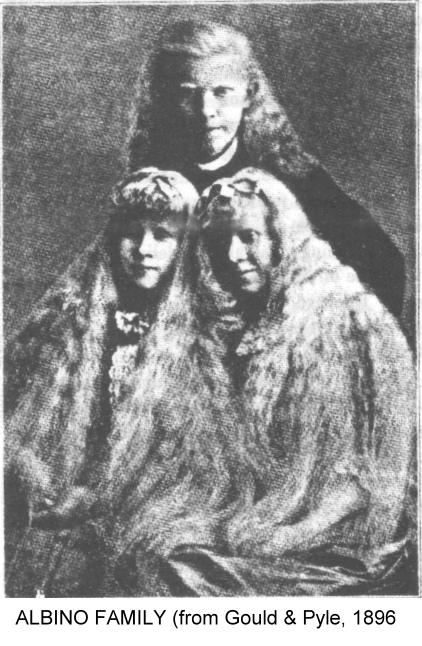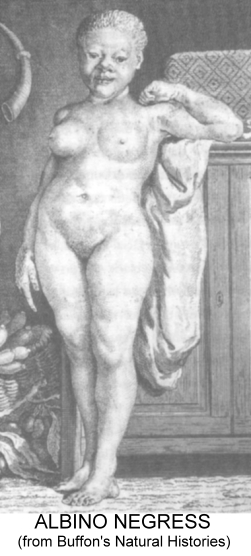|
|
|
ALBINO HUMANS
Albinism and piebaldism can be found in humans of all races although these are probably most startling when they occur in dark-skinned people. The naturalist George le Clerc Buffon described and illustrated albino and piebald humans in his Natural Histories (1777). The following text is taken from "Anomalies and Curiosities of Medicine" by George M Gould and Walter L Pyle, published in 1896 (the language and terms used are therefore archaic). The illustrations are mostly taken from Gould & Pyle and from Buffon.
Albinism is characterized by the absolute or relative absence of pigment of the skin, due to an arrest, insufficiency, or retardation of this pigment. Following Trélat and Guinard, we may divide albinism into two classes, - general and partial.

As to the etiology of albinism, there is no known cause of the complete form. Heredity plays no part in a number of cases investigated by the authors. D’Aubé, by his observations on white rabbits, believes that the influence of con-sanguinity is a marked factor in the production of albinism; there are, however, many instances of heredity in this anomaly on record, and this idea is possibly in harmony with the majority of observers. Geoffroy Saint-Hilaire has noted that albinism can also be the consequence of a pathologic condition having its origin in adverse surroundings, the circumstances of the parents, such as the want of exercise, nourishment, light, etc. Lesser knew a family in which six out of seven were albinos, and in some tropical countries, such as Loango, Lower Guinea, it is said to be endemic. It is exceptional for the parents to be affected; but in a case of Schlegel, quoted by Crocker, the grandfather was an albino, and Mareya describes the case of the Cape May albinos, in which the mother and father were “fair emblems of the African race,” and of their children three were black and three were white, born in the following order : two consecutive black boys, two consecutive white girls, one black girl, one white boy. Sym of Edinburgh relates the history of a family of seven children, who were alternately white and black. All but the seventh were living and in good health and mentally without defect. The parents and other relatives were dark. Figure 73 [shown here to the left] portrays an albino family by the name of Cavalier who exhibited in Minneapolis in 1887.
Examples of the total absence of pigment occur in all races, but particularly is it interesting when seen in negroes who are found absolutely white but preserving all the characteristics of their race, as, for instance, the kinky, woolly hair, flattened nose, thick lips, etc. René Caillé, in his “Voyage à Tombouctou," says that he saw a white infant, the offspring of a negro and negress. Its hair was white, its eyes blue, and its lashes flaxen . Its pupils were of a reddish color, and its physiognomy that of a Mandingo. He says such cases are not at all uncommon; they are really negro albinos. Thomas Jefferson, in his “History of Virginia,” has an excellent description of these negroes, with their tremulous and weak eyes; he remarks that they freckle easily. Buffon speaks of Ethiops with white twins, and says that albinos are quite common in Africa, being generally of delicate constitution, twinkling eyes, and of a low degree of intelligence ; they are despised and ill-treated by the other negroes. Prichard, quoted by Sedgwick, speaks of a case of atavic [throwback] transmission of albinism through the male line of the negro race. The grandfather and the grandchild were albinos, the father being black. There is a case of a brother and sister who were albinos, the parents being of ordinary color but the grandfather an albino. Coinde, quoted by Sedgwick, speaks of a man who, by two different wives, had three albino children.

A description of the ordinary type of albino would be as follows : The skin and hair are deprived of pigment; the eyebrows and eyelashes are of a brilliant white or are yellowish; the iris and the choroid are nearly or entirely deprived of coloring material, and in looking at the eye we see a roseate zone and the ordinary pink pupil; from absence of pigment they necessarily keep their eves three-quarters closed, being photophobic to a high degree. They are amblyopic, and this is due partially to a high degree of ametropia (caused by crushing of the eyeball in the endeavor to shut out light) and from retinal exhaustion and nystagmus. Many authors have claimed that they have little intelligence, but this opinion is not true. Ordinarily the reproductive functions are normal, and if we exclude the results of the union of two albinos we may say that these individuals are fecund.
Partial albinism is seen. The parts most often affected are the genitals, the hair, the face, the top of the trunk, the nipple, the back of the hands and fingers. Folker reports the history of a case of an albino girl having pink eyes and red hair, the rest of the family having pink eyes and white hair. Partial albinism, necessarily congenital, presenting a piebald appearance, must not be confounded with leukoderma, which is rarely seen in the young and which will be described later.
Albinism is found in the lower animals, and is exemplified ordinarily by rats, mice, crows, robins, etc. In the Zoologic Garden at Baltimore two years ago was a pair of pure albino opossums. The white elephant is celebrated in the religious history of Oriental nations, and is an object of veneration and worship in Siam. White monkeys and white roosters are also worshiped. In the Natural History Museum in London there are stuffed examples of albinism and melanism in the lower animals.
Melanism is an anomaly, the exact contrary of the preceding. It is characterized by the presence in the tissues and skin of an excessive amount of pigment. True total melanism is unknown in man, in whom is only observed partial melanism, characterized simply by a pronounced coloration of part of the integument.
Some curious instances have been related a of an infant with a two-colored face, and of others with one side of the face white and the other black; whether they were cases of partial albinism or partial melanism cannot be ascertained from the descriptions.
|
|
|